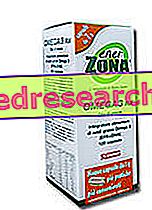
About Omega 3 RX - Enerzona
OMEGA 3 RX- ENERZONA
Food supplement of omega 3 essential fatty acids
FORMAT
Pack of 48/120/210/240 capsules of 1 gram
COMPOSITION
fish oil standardized in Omega 3 (75%)
Gelatin
Resistance agent: glycerol
Antioxidants: Vitamin E, ascorbyl palmitate, rosemary extract
Acidifier: citric acid
Nutritional information
Per 1 gram capsule
EPA 400 mg
DHA 200 mg
Omega 3 750 mg
Product features Omega 3 RX - Enerzona
Product features: The Omega 3 RX of the power plant is one of the few omega 3 fatty acid supplements whose quality is certified by the IFOS program. The high content of omega 3 - observed around 750 mg per capsule of 1 gram, of which 600 mg between EPA + DHA - the absence of heavy metals (mercury, lead, copper and arsenic) and toxic substances such as dioxins and furani, together with the presence of natural antioxidants and the low level of fatty acid oxidation, make the Omega 3 RX fall into the best possible category of omega 3 (ULTRA REFINED) based supplements.
Another prerogative of this product is the absence of fish flavor, which generally accompanies most supplements of this kind, and which can objectively be measured through a patented analytical technique known as FAST.
The high cost that characterizes this omega three supplement is therefore totally justified by a very high certified quality.
Omega 3 fatty acids - series of polyunsaturated fatty acids characterized by the presence of double bonds, the first of which is present at the level of the third carbon starting from the terminal one. Although this class of lipids includes different types of molecules, the fatty acids that can be attributed a benefit in terms of biological functionality are essentially three:
- Alpha linolenic acid (ALA): fatty acid with 18 carbon atoms with 3 double bonds, present in products of vegetable origin such as walnuts (4 nuts are able to provide about 1.8 grams of ALA) and seeds and linseed oil. Alpha linolenic acid is the substrate of the elongase and desaturase enzymes, whose activity is linked to the endogenous synthesis, albeit minimal, of EPA and DHA.
- Eicosapentanoic acid (EPA) and docosahexaonic acid (DHA): characterized respectively by a carbon skeleton of 20 and 22 carbon atoms, and by 5 and 6 double bonds. The main food source of these products is given by fish and algae, from which it is generally extracted.
Although the human body is able to provide for the synthesis of these products, the total quota reached is absolutely not able to satisfy the daily request, therefore it is necessary to resort to food intake. It has been estimated that the consumption of 4 portions of fish per week, perhaps alternating with the intake of nuts or other seeds rich in ALA, may be sufficient to satisfy the nutritional needs of even adult individuals, whose daily needs seem to be wandering around around 2 grams.
Omega 3 and wellness
The omega 3 fatty acids have taken on a very important role in maintaining the human well-being condition. In fact, old experimental evidences attributed to these acids (in particular to the fish consumed in the diet) the reason for the low incidence of cardiovascular events in the Eskimo population. Only after a few years of studies and a lot of research, has the biological role of these molecules involved in the:
- Improve blood flow and reduce vascular pressure;
- Protect the heart from arrhythmias and conduction disorders;
- Reduce the secretion of inflammatory cytokines, and protect the body from excessive inflammatory stress;
- Preserve and improve neuronal function;
- Protect from certain diseases, including tumors (still in the experimental phase).
In reality all these biological effects are not linked exclusively to the intake of omega 3, but to the rebalancing of a very important relationship (omega6 / omega3), definitely unbalanced in the western diet and responsible for the high incidence of cardiovascular diseases.
Omega 3 and sport
Given the importance to human health, and given the physical and psychological stresses to which an athlete, especially if he is an agonist, is subjected, it was decided to experiment with the use of omega three also in sports dietetics, in order to reduce the damage induced by physical exercise and protect the athlete from possible injuries and associated pathologies. It was thus possible to observe how the correct integration with omega 3, is not only crucial for the protective action, but can also guarantee an improvement of some conditions necessary to sustain athletic performance. More precisely, supplementation with omega 3 was useful in:
- Reduce inflammatory damage induced by exercise, and prevent functional and structural deterioration of muscles, tendons and ligaments;
- Support cardiac function, reduce vascular resistance and improve the hemodynamic capacity of the athlete;
- Improve ventilatory capacities and ensure better general oxygenation;
- Speed up reaction times and improve the concentration skills of competitive athletes.
Of course, even for athletes it is important to ensure a correct balance between omega3 and omega6, and the greatest daily requirement in absolute value of omega 3 is precisely justified by a relative increase in omega 6, due to particularly rich feeds of products of animal origin and vegetable oils.
Recommended use by the company - Omega 3 RX - Enerzona
Take 2 to 4 capsules per day, corresponding to about 2.5 grams of long chain omega 3 (EPA + DHA)
Use in sports - Omega 3 RX - Enerzona
As suggested by the manufacturer, 2.5 grams per day are the most used and most effective dosage documented by the scientific literature. Naturally, the definition of a "perfect" dosage should first of all include the calculation of omega 6 and omega 3 introduced through the diet, to then go to optimize the quota through integration, in order to maintain a relationship between these two categories between 2: 1 and 6: 1.
The intake of omega-three should be prolonged for at least 4 weeks and preferred during meals, in order to facilitate bile-mediated intestinal absorption.
Synergies - Omega 3 RX - Enerzona
Several studies show a greater efficacy of action associating to the omega 3 antioxidant substances able to assist the protective action on the stability of the plasma membranes.
Furthermore, for supplementation to guarantee the effects described, it is also necessary that the diet follows the general principles of a healthy diet and is accompanied by controlled exercise.
Side effects Omega 3 RX - Enerzona
Excessive intake of omega 3 can be associated with immediate phenomena such as nausea, vomiting, gastric and erythema burning, and systemic effects of a different nature.
In the literature, cases of bleeding (due to the anticoagulant action of the omega 3) are described; therefore it is necessary to pay attention to possible interactions with aspirin or other anticoagulants, and in the case of haemophilic pathology or alterations of the glycemic profile in patients suffering from non insulin dependent diabetic pathology.
It should be reiterated that the dose between 2 and 5 grams per day seems to be quite safe, and without the aforementioned side effects.
Precautions for use Omega 3 RX - Enerzona
The product is contraindicated in cases of renal or hepatic disease, cardiovascular disease and / or hypertension, allergies and autoimmune diseases, during pregnancy, during breastfeeding, under 12 years and for adolescents not yet trained.
In the event of prolonged use (over 6/8 weeks), medical advice is required.
This article, elaborated on the critical re-reading of scientific articles, university texts and common practice, is for informational purposes only and is therefore not a medical prescription. It is therefore always necessary to consult your doctor, nutritionist or pharmacist before starting to use any kind of supplement . Further information on the critical analysis of Omega 3 RX - Enerzona.
| BIBLIOGRAPHY |
J Am Coll Nutr. 2009 Aug; 28 Suppl: 473S-481S. Effect of omega-3 and policosanol supplementation on attention and reactivity in athletes. Fontani G, Lodi L, Migliorini S, Corradeschi F. Int J Sport Nutr Exerc Metab. 2009 Oct; 19 (5): 536-46. n-3 polyunsaturated fatty acidsNieman DC, Henson DA, McAnulty SR, Jin F, Maxwell KR. Nutr Res. 2009 May; 29 (5): 305-12. Cardiovascular risk factors in young, overweight, and obese Europeans and associations with physical activity and omega-3 index.Ramel A, Pumberger C, Martinéz AJ, Kiely M, Bandarra NM, Thorsdottir I. J Sci Med Sport. 2010 Mar; 13 (2): 281-6. Epub 2009 Jun 12. Tartibian B, Maleki BH, Abbasi A. Clin J Sport Med. 2009 Mar; 19 (2): 115-9. The effects of ingestion of omega-3 fatty acids on perceived pain and external symptoms of delayed onset muscle soreness in untrained men.Tartibian B, Maleki BH, Abbasi A. Eur J Appl Physiol. 2008 Oct; 104 (3): 455-61. Epub 2008 Jun 18. Omega-3 fatty acid supplementation enhances stroke volume and cardiac output during dynamic exercise.Walser B, Stebbins CL. J Sci Med Sport. 2009 Jul; 12 (4): 503-7. Epub 2008 Jun 13. DHA-rich fish oil lowers heart rate during submaximal exercise in elite Australian Rules footballers.Buckley JD, Burgess S, Murphy KJ, Howe PR. Curr Sports Med Rep. 2007 Jul; 6 (4): 230-6. Omega-3 fatty acids and athletics.Simopoulos AP. Am J Clin Nutr. 2007 Mar; 85 (3): 803-7. Högström M, Nordström P, Nordström A. J Psychiatr Res. 2008 Jan; 42 (1): 58-63. Epub 2006 Oct 30. Omega-3 fatty acids on the forced-swimming test.Huang SY, Yang HT, Chiu CC, Pariante CM, Su KP. Eur J Appl Physiol. 2004 Aug; 92 (4-5): 584-91. Epub 2004 Mar 30. Effect of n-3 fatty acids on free tryptophan and exercise fatigue.Huffman DM, Altena TS, Mawhinney TP, Thomas TR. Crit Care Clin. 2010 Jul; 26 (3): 501-514. Fish Oil in Critical Illness: Mechanisms and Clinical Applications.Stapleton RD, Martin JM, Mayer K. J Alzheimers Dis. 2010 Jul 15. [Epub ahead of print] Huang TL. Cardiovasc Ther. 2010 Aug; 28 (4): 202-15. Nutraceuticals and atherosclerosis: human trials.Badimon L, Vilahur G, Padro T. Cell Mol Biol (Noisy-le-grand). 2010 Feb 25; 56 (1): 28-37. Omega-3 (n-3) fatty acids, cardiovascular disease and stability of atherosclerotic plaques.Calder PC, Yaqoob P. BMC Cardiovasc Disord. 2010 Jun 3; 10: 24. Omega-3 fatty acids in high-risk cardiovascular patients: a meta-analysis of randomized controlled trials. |



